Environmental Impact Assessment and Water Conservation Report
VerifiedAdded on 2022/11/22
|9
|2392
|413
Report
AI Summary
This report analyzes the Environmental Impact Assessment (EIA) processes in New South Wales (NSW) and Queensland, Australia, highlighting the drawbacks of the current EIA system in NSW, particularly its technocratic approach and the imposition of conditions that increase costs and discourage investment. It contrasts this with Queensland's approach. The report then proposes a strategy for household water conservation, emphasizing the use of "soft tools" such as regulatory measures (laws and standards), economic incentives (cost-benefit analysis), and social tools (behavioral change initiatives). It examines existing water conservation practices in Australia, including rainwater tank installations and water usage regulations, and suggests modifications and integrated approaches to maximize the effectiveness of the proposed soft tools. The report also provides relevant references from various sources to support the analysis and the proposed strategies.
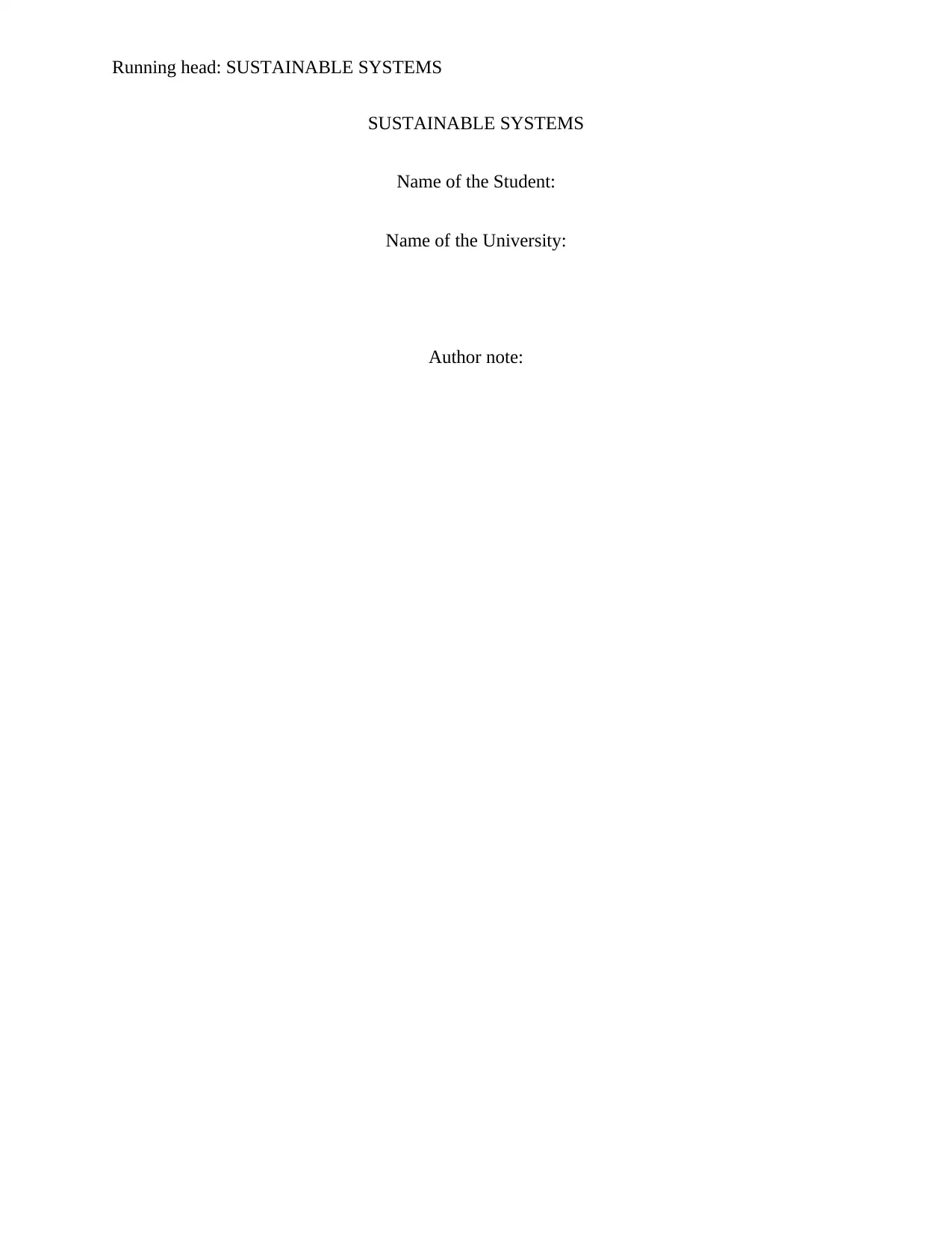
Running head: SUSTAINABLE SYSTEMS
SUSTAINABLE SYSTEMS
Name of the Student:
Name of the University:
Author note:
SUSTAINABLE SYSTEMS
Name of the Student:
Name of the University:
Author note:
Paraphrase This Document
Need a fresh take? Get an instant paraphrase of this document with our AI Paraphraser
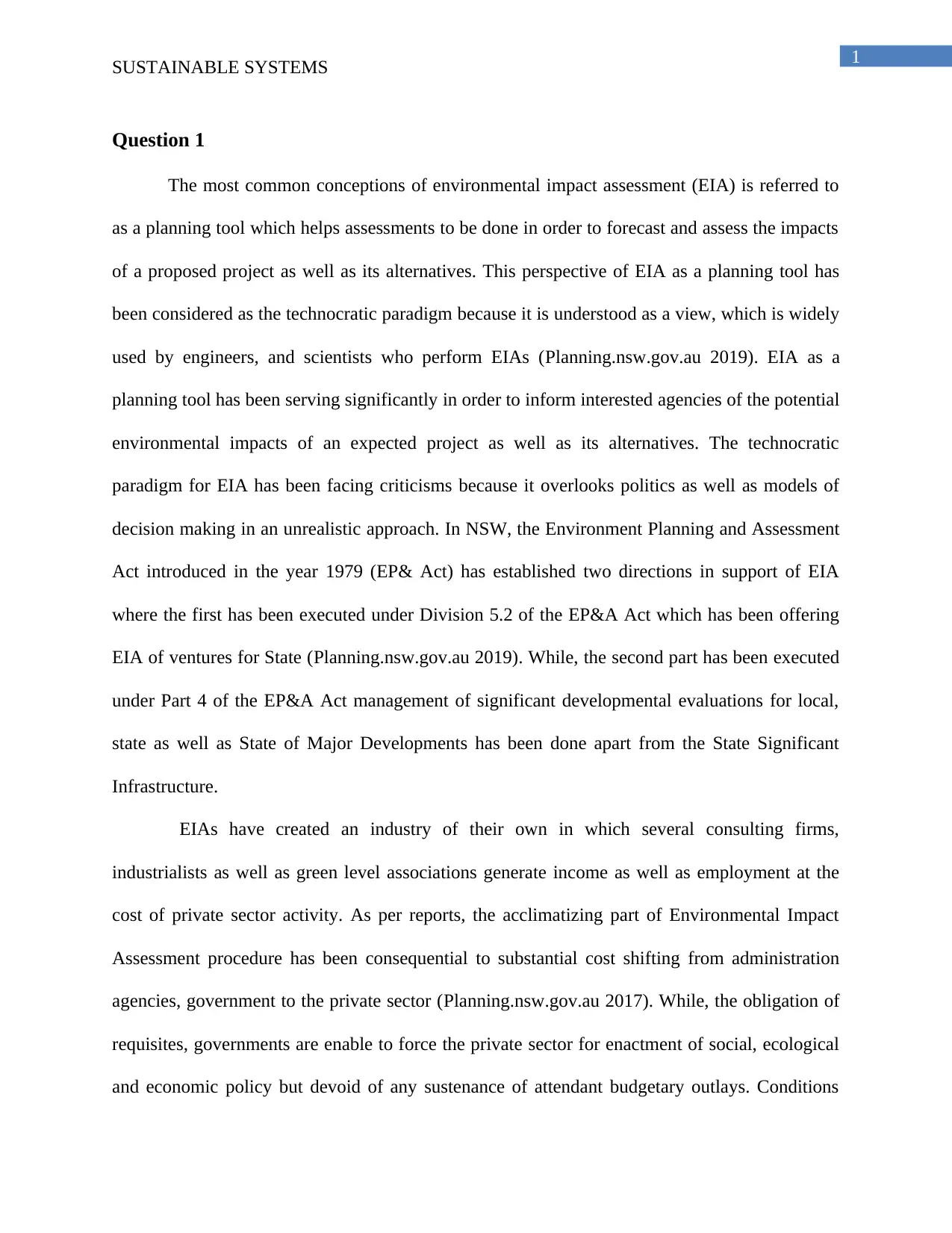
1
SUSTAINABLE SYSTEMS
Question 1
The most common conceptions of environmental impact assessment (EIA) is referred to
as a planning tool which helps assessments to be done in order to forecast and assess the impacts
of a proposed project as well as its alternatives. This perspective of EIA as a planning tool has
been considered as the technocratic paradigm because it is understood as a view, which is widely
used by engineers, and scientists who perform EIAs (Planning.nsw.gov.au 2019). EIA as a
planning tool has been serving significantly in order to inform interested agencies of the potential
environmental impacts of an expected project as well as its alternatives. The technocratic
paradigm for EIA has been facing criticisms because it overlooks politics as well as models of
decision making in an unrealistic approach. In NSW, the Environment Planning and Assessment
Act introduced in the year 1979 (EP& Act) has established two directions in support of EIA
where the first has been executed under Division 5.2 of the EP&A Act which has been offering
EIA of ventures for State (Planning.nsw.gov.au 2019). While, the second part has been executed
under Part 4 of the EP&A Act management of significant developmental evaluations for local,
state as well as State of Major Developments has been done apart from the State Significant
Infrastructure.
EIAs have created an industry of their own in which several consulting firms,
industrialists as well as green level associations generate income as well as employment at the
cost of private sector activity. As per reports, the acclimatizing part of Environmental Impact
Assessment procedure has been consequential to substantial cost shifting from administration
agencies, government to the private sector (Planning.nsw.gov.au 2017). While, the obligation of
requisites, governments are enable to force the private sector for enactment of social, ecological
and economic policy but devoid of any sustenance of attendant budgetary outlays. Conditions
SUSTAINABLE SYSTEMS
Question 1
The most common conceptions of environmental impact assessment (EIA) is referred to
as a planning tool which helps assessments to be done in order to forecast and assess the impacts
of a proposed project as well as its alternatives. This perspective of EIA as a planning tool has
been considered as the technocratic paradigm because it is understood as a view, which is widely
used by engineers, and scientists who perform EIAs (Planning.nsw.gov.au 2019). EIA as a
planning tool has been serving significantly in order to inform interested agencies of the potential
environmental impacts of an expected project as well as its alternatives. The technocratic
paradigm for EIA has been facing criticisms because it overlooks politics as well as models of
decision making in an unrealistic approach. In NSW, the Environment Planning and Assessment
Act introduced in the year 1979 (EP& Act) has established two directions in support of EIA
where the first has been executed under Division 5.2 of the EP&A Act which has been offering
EIA of ventures for State (Planning.nsw.gov.au 2019). While, the second part has been executed
under Part 4 of the EP&A Act management of significant developmental evaluations for local,
state as well as State of Major Developments has been done apart from the State Significant
Infrastructure.
EIAs have created an industry of their own in which several consulting firms,
industrialists as well as green level associations generate income as well as employment at the
cost of private sector activity. As per reports, the acclimatizing part of Environmental Impact
Assessment procedure has been consequential to substantial cost shifting from administration
agencies, government to the private sector (Planning.nsw.gov.au 2017). While, the obligation of
requisites, governments are enable to force the private sector for enactment of social, ecological
and economic policy but devoid of any sustenance of attendant budgetary outlays. Conditions
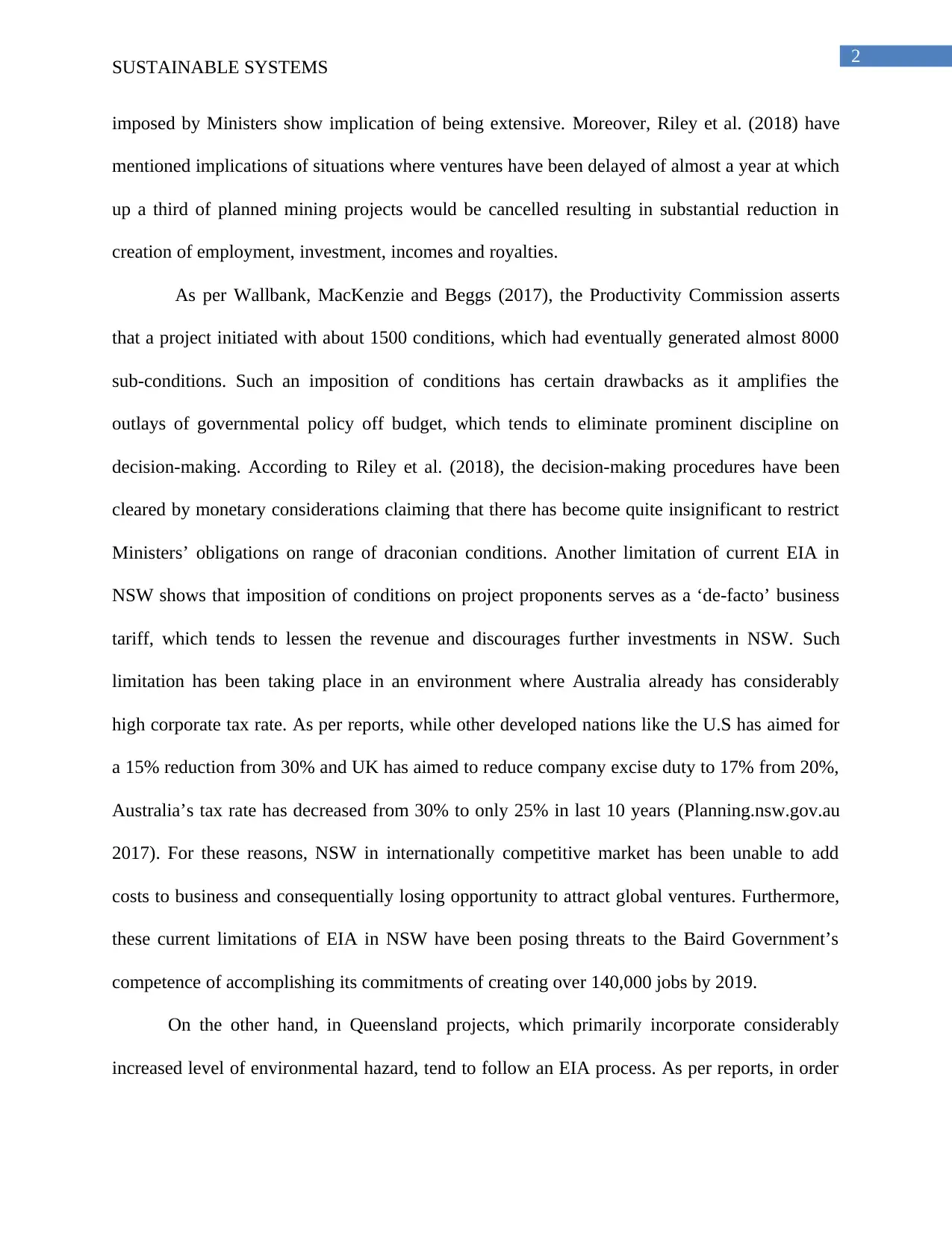
2
SUSTAINABLE SYSTEMS
imposed by Ministers show implication of being extensive. Moreover, Riley et al. (2018) have
mentioned implications of situations where ventures have been delayed of almost a year at which
up a third of planned mining projects would be cancelled resulting in substantial reduction in
creation of employment, investment, incomes and royalties.
As per Wallbank, MacKenzie and Beggs (2017), the Productivity Commission asserts
that a project initiated with about 1500 conditions, which had eventually generated almost 8000
sub-conditions. Such an imposition of conditions has certain drawbacks as it amplifies the
outlays of governmental policy off budget, which tends to eliminate prominent discipline on
decision-making. According to Riley et al. (2018), the decision-making procedures have been
cleared by monetary considerations claiming that there has become quite insignificant to restrict
Ministers’ obligations on range of draconian conditions. Another limitation of current EIA in
NSW shows that imposition of conditions on project proponents serves as a ‘de-facto’ business
tariff, which tends to lessen the revenue and discourages further investments in NSW. Such
limitation has been taking place in an environment where Australia already has considerably
high corporate tax rate. As per reports, while other developed nations like the U.S has aimed for
a 15% reduction from 30% and UK has aimed to reduce company excise duty to 17% from 20%,
Australia’s tax rate has decreased from 30% to only 25% in last 10 years (Planning.nsw.gov.au
2017). For these reasons, NSW in internationally competitive market has been unable to add
costs to business and consequentially losing opportunity to attract global ventures. Furthermore,
these current limitations of EIA in NSW have been posing threats to the Baird Government’s
competence of accomplishing its commitments of creating over 140,000 jobs by 2019.
On the other hand, in Queensland projects, which primarily incorporate considerably
increased level of environmental hazard, tend to follow an EIA process. As per reports, in order
SUSTAINABLE SYSTEMS
imposed by Ministers show implication of being extensive. Moreover, Riley et al. (2018) have
mentioned implications of situations where ventures have been delayed of almost a year at which
up a third of planned mining projects would be cancelled resulting in substantial reduction in
creation of employment, investment, incomes and royalties.
As per Wallbank, MacKenzie and Beggs (2017), the Productivity Commission asserts
that a project initiated with about 1500 conditions, which had eventually generated almost 8000
sub-conditions. Such an imposition of conditions has certain drawbacks as it amplifies the
outlays of governmental policy off budget, which tends to eliminate prominent discipline on
decision-making. According to Riley et al. (2018), the decision-making procedures have been
cleared by monetary considerations claiming that there has become quite insignificant to restrict
Ministers’ obligations on range of draconian conditions. Another limitation of current EIA in
NSW shows that imposition of conditions on project proponents serves as a ‘de-facto’ business
tariff, which tends to lessen the revenue and discourages further investments in NSW. Such
limitation has been taking place in an environment where Australia already has considerably
high corporate tax rate. As per reports, while other developed nations like the U.S has aimed for
a 15% reduction from 30% and UK has aimed to reduce company excise duty to 17% from 20%,
Australia’s tax rate has decreased from 30% to only 25% in last 10 years (Planning.nsw.gov.au
2017). For these reasons, NSW in internationally competitive market has been unable to add
costs to business and consequentially losing opportunity to attract global ventures. Furthermore,
these current limitations of EIA in NSW have been posing threats to the Baird Government’s
competence of accomplishing its commitments of creating over 140,000 jobs by 2019.
On the other hand, in Queensland projects, which primarily incorporate considerably
increased level of environmental hazard, tend to follow an EIA process. As per reports, in order
⊘ This is a preview!⊘
Do you want full access?
Subscribe today to unlock all pages.

Trusted by 1+ million students worldwide
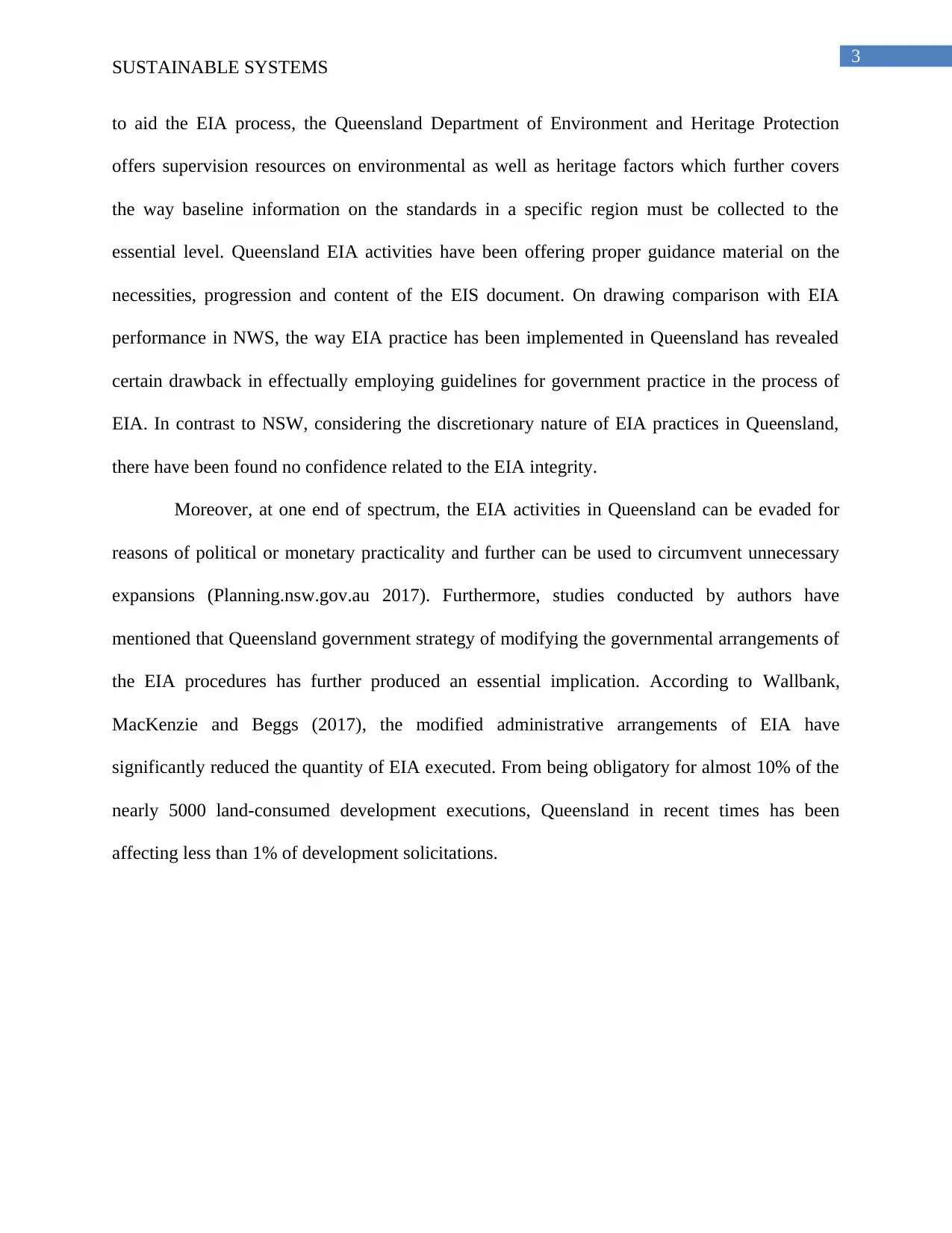
3
SUSTAINABLE SYSTEMS
to aid the EIA process, the Queensland Department of Environment and Heritage Protection
offers supervision resources on environmental as well as heritage factors which further covers
the way baseline information on the standards in a specific region must be collected to the
essential level. Queensland EIA activities have been offering proper guidance material on the
necessities, progression and content of the EIS document. On drawing comparison with EIA
performance in NWS, the way EIA practice has been implemented in Queensland has revealed
certain drawback in effectually employing guidelines for government practice in the process of
EIA. In contrast to NSW, considering the discretionary nature of EIA practices in Queensland,
there have been found no confidence related to the EIA integrity.
Moreover, at one end of spectrum, the EIA activities in Queensland can be evaded for
reasons of political or monetary practicality and further can be used to circumvent unnecessary
expansions (Planning.nsw.gov.au 2017). Furthermore, studies conducted by authors have
mentioned that Queensland government strategy of modifying the governmental arrangements of
the EIA procedures has further produced an essential implication. According to Wallbank,
MacKenzie and Beggs (2017), the modified administrative arrangements of EIA have
significantly reduced the quantity of EIA executed. From being obligatory for almost 10% of the
nearly 5000 land-consumed development executions, Queensland in recent times has been
affecting less than 1% of development solicitations.
SUSTAINABLE SYSTEMS
to aid the EIA process, the Queensland Department of Environment and Heritage Protection
offers supervision resources on environmental as well as heritage factors which further covers
the way baseline information on the standards in a specific region must be collected to the
essential level. Queensland EIA activities have been offering proper guidance material on the
necessities, progression and content of the EIS document. On drawing comparison with EIA
performance in NWS, the way EIA practice has been implemented in Queensland has revealed
certain drawback in effectually employing guidelines for government practice in the process of
EIA. In contrast to NSW, considering the discretionary nature of EIA practices in Queensland,
there have been found no confidence related to the EIA integrity.
Moreover, at one end of spectrum, the EIA activities in Queensland can be evaded for
reasons of political or monetary practicality and further can be used to circumvent unnecessary
expansions (Planning.nsw.gov.au 2017). Furthermore, studies conducted by authors have
mentioned that Queensland government strategy of modifying the governmental arrangements of
the EIA procedures has further produced an essential implication. According to Wallbank,
MacKenzie and Beggs (2017), the modified administrative arrangements of EIA have
significantly reduced the quantity of EIA executed. From being obligatory for almost 10% of the
nearly 5000 land-consumed development executions, Queensland in recent times has been
affecting less than 1% of development solicitations.
Paraphrase This Document
Need a fresh take? Get an instant paraphrase of this document with our AI Paraphraser
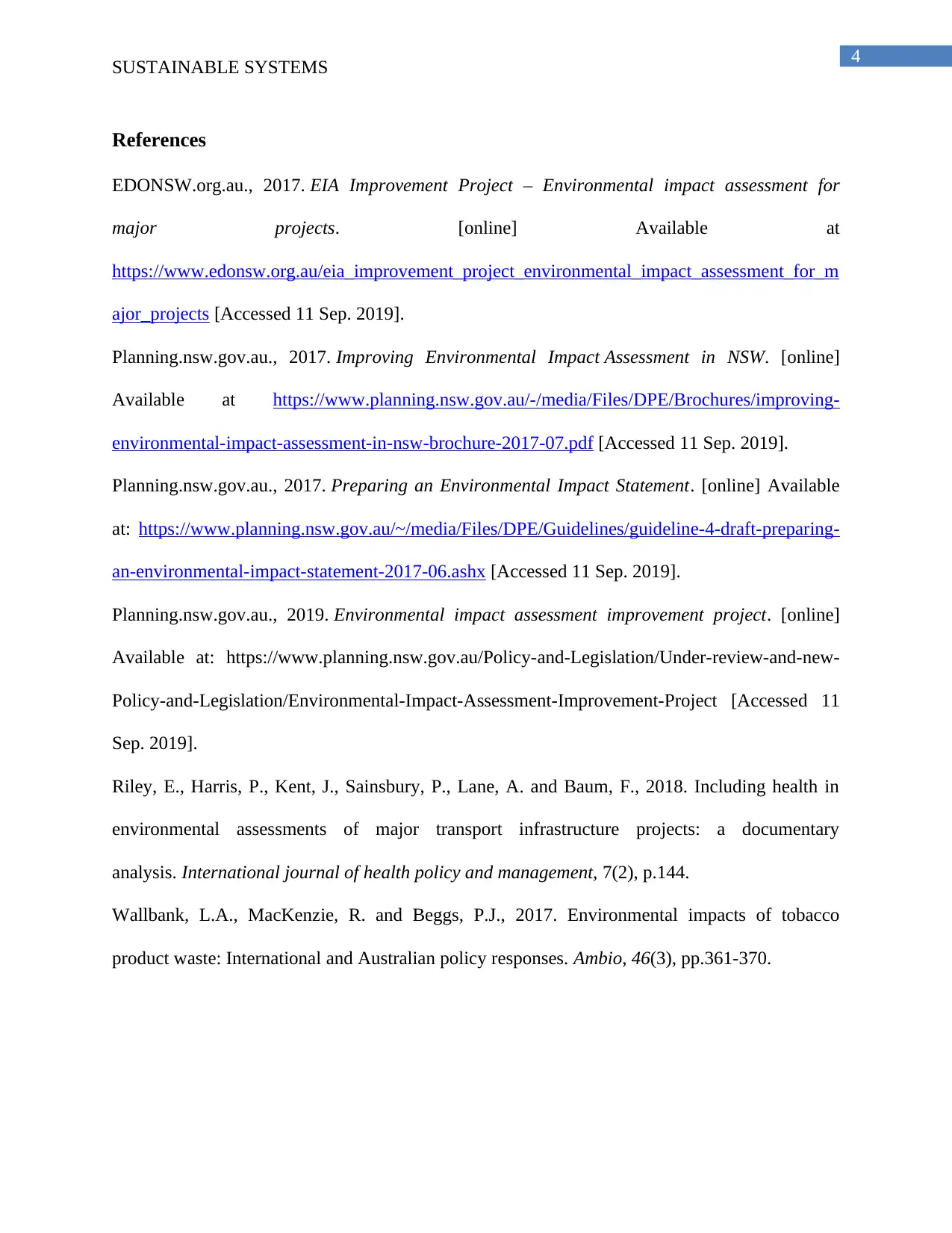
4
SUSTAINABLE SYSTEMS
References
EDONSW.org.au., 2017. EIA Improvement Project – Environmental impact assessment for
major projects. [online] Available at
https://www.edonsw.org.au/eia_improvement_project_environmental_impact_assessment_for_m
ajor_projects [Accessed 11 Sep. 2019].
Planning.nsw.gov.au., 2017. Improving Environmental Impact Assessment in NSW. [online]
Available at https://www.planning.nsw.gov.au/-/media/Files/DPE/Brochures/improving-
environmental-impact-assessment-in-nsw-brochure-2017-07.pdf [Accessed 11 Sep. 2019].
Planning.nsw.gov.au., 2017. Preparing an Environmental Impact Statement. [online] Available
at: https://www.planning.nsw.gov.au/~/media/Files/DPE/Guidelines/guideline-4-draft-preparing-
an-environmental-impact-statement-2017-06.ashx [Accessed 11 Sep. 2019].
Planning.nsw.gov.au., 2019. Environmental impact assessment improvement project. [online]
Available at: https://www.planning.nsw.gov.au/Policy-and-Legislation/Under-review-and-new-
Policy-and-Legislation/Environmental-Impact-Assessment-Improvement-Project [Accessed 11
Sep. 2019].
Riley, E., Harris, P., Kent, J., Sainsbury, P., Lane, A. and Baum, F., 2018. Including health in
environmental assessments of major transport infrastructure projects: a documentary
analysis. International journal of health policy and management, 7(2), p.144.
Wallbank, L.A., MacKenzie, R. and Beggs, P.J., 2017. Environmental impacts of tobacco
product waste: International and Australian policy responses. Ambio, 46(3), pp.361-370.
SUSTAINABLE SYSTEMS
References
EDONSW.org.au., 2017. EIA Improvement Project – Environmental impact assessment for
major projects. [online] Available at
https://www.edonsw.org.au/eia_improvement_project_environmental_impact_assessment_for_m
ajor_projects [Accessed 11 Sep. 2019].
Planning.nsw.gov.au., 2017. Improving Environmental Impact Assessment in NSW. [online]
Available at https://www.planning.nsw.gov.au/-/media/Files/DPE/Brochures/improving-
environmental-impact-assessment-in-nsw-brochure-2017-07.pdf [Accessed 11 Sep. 2019].
Planning.nsw.gov.au., 2017. Preparing an Environmental Impact Statement. [online] Available
at: https://www.planning.nsw.gov.au/~/media/Files/DPE/Guidelines/guideline-4-draft-preparing-
an-environmental-impact-statement-2017-06.ashx [Accessed 11 Sep. 2019].
Planning.nsw.gov.au., 2019. Environmental impact assessment improvement project. [online]
Available at: https://www.planning.nsw.gov.au/Policy-and-Legislation/Under-review-and-new-
Policy-and-Legislation/Environmental-Impact-Assessment-Improvement-Project [Accessed 11
Sep. 2019].
Riley, E., Harris, P., Kent, J., Sainsbury, P., Lane, A. and Baum, F., 2018. Including health in
environmental assessments of major transport infrastructure projects: a documentary
analysis. International journal of health policy and management, 7(2), p.144.
Wallbank, L.A., MacKenzie, R. and Beggs, P.J., 2017. Environmental impacts of tobacco
product waste: International and Australian policy responses. Ambio, 46(3), pp.361-370.
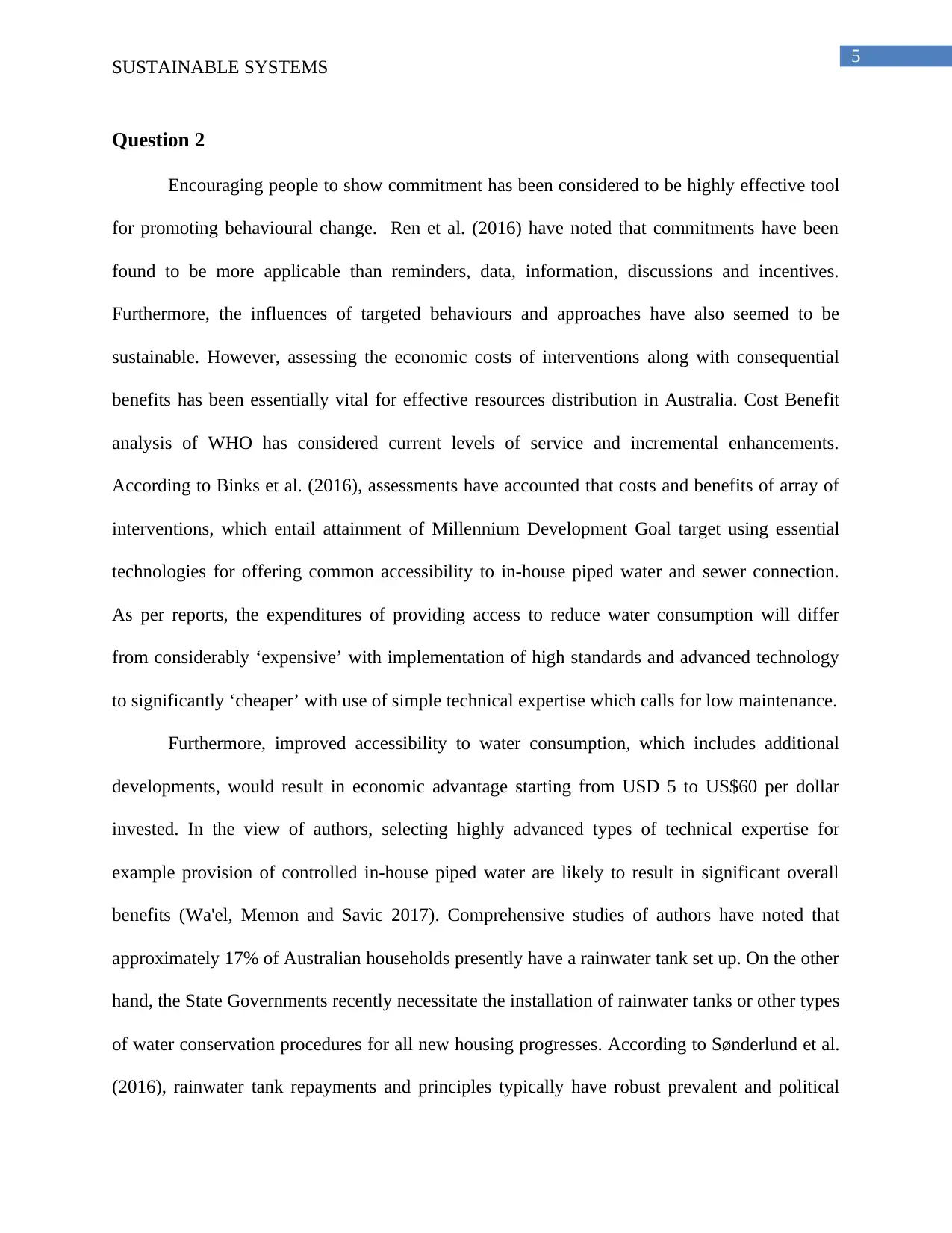
5
SUSTAINABLE SYSTEMS
Question 2
Encouraging people to show commitment has been considered to be highly effective tool
for promoting behavioural change. Ren et al. (2016) have noted that commitments have been
found to be more applicable than reminders, data, information, discussions and incentives.
Furthermore, the influences of targeted behaviours and approaches have also seemed to be
sustainable. However, assessing the economic costs of interventions along with consequential
benefits has been essentially vital for effective resources distribution in Australia. Cost Benefit
analysis of WHO has considered current levels of service and incremental enhancements.
According to Binks et al. (2016), assessments have accounted that costs and benefits of array of
interventions, which entail attainment of Millennium Development Goal target using essential
technologies for offering common accessibility to in-house piped water and sewer connection.
As per reports, the expenditures of providing access to reduce water consumption will differ
from considerably ‘expensive’ with implementation of high standards and advanced technology
to significantly ‘cheaper’ with use of simple technical expertise which calls for low maintenance.
Furthermore, improved accessibility to water consumption, which includes additional
developments, would result in economic advantage starting from USD 5 to US$60 per dollar
invested. In the view of authors, selecting highly advanced types of technical expertise for
example provision of controlled in-house piped water are likely to result in significant overall
benefits (Wa'el, Memon and Savic 2017). Comprehensive studies of authors have noted that
approximately 17% of Australian households presently have a rainwater tank set up. On the other
hand, the State Governments recently necessitate the installation of rainwater tanks or other types
of water conservation procedures for all new housing progresses. According to Sønderlund et al.
(2016), rainwater tank repayments and principles typically have robust prevalent and political
SUSTAINABLE SYSTEMS
Question 2
Encouraging people to show commitment has been considered to be highly effective tool
for promoting behavioural change. Ren et al. (2016) have noted that commitments have been
found to be more applicable than reminders, data, information, discussions and incentives.
Furthermore, the influences of targeted behaviours and approaches have also seemed to be
sustainable. However, assessing the economic costs of interventions along with consequential
benefits has been essentially vital for effective resources distribution in Australia. Cost Benefit
analysis of WHO has considered current levels of service and incremental enhancements.
According to Binks et al. (2016), assessments have accounted that costs and benefits of array of
interventions, which entail attainment of Millennium Development Goal target using essential
technologies for offering common accessibility to in-house piped water and sewer connection.
As per reports, the expenditures of providing access to reduce water consumption will differ
from considerably ‘expensive’ with implementation of high standards and advanced technology
to significantly ‘cheaper’ with use of simple technical expertise which calls for low maintenance.
Furthermore, improved accessibility to water consumption, which includes additional
developments, would result in economic advantage starting from USD 5 to US$60 per dollar
invested. In the view of authors, selecting highly advanced types of technical expertise for
example provision of controlled in-house piped water are likely to result in significant overall
benefits (Wa'el, Memon and Savic 2017). Comprehensive studies of authors have noted that
approximately 17% of Australian households presently have a rainwater tank set up. On the other
hand, the State Governments recently necessitate the installation of rainwater tanks or other types
of water conservation procedures for all new housing progresses. According to Sønderlund et al.
(2016), rainwater tank repayments and principles typically have robust prevalent and political
⊘ This is a preview!⊘
Do you want full access?
Subscribe today to unlock all pages.

Trusted by 1+ million students worldwide
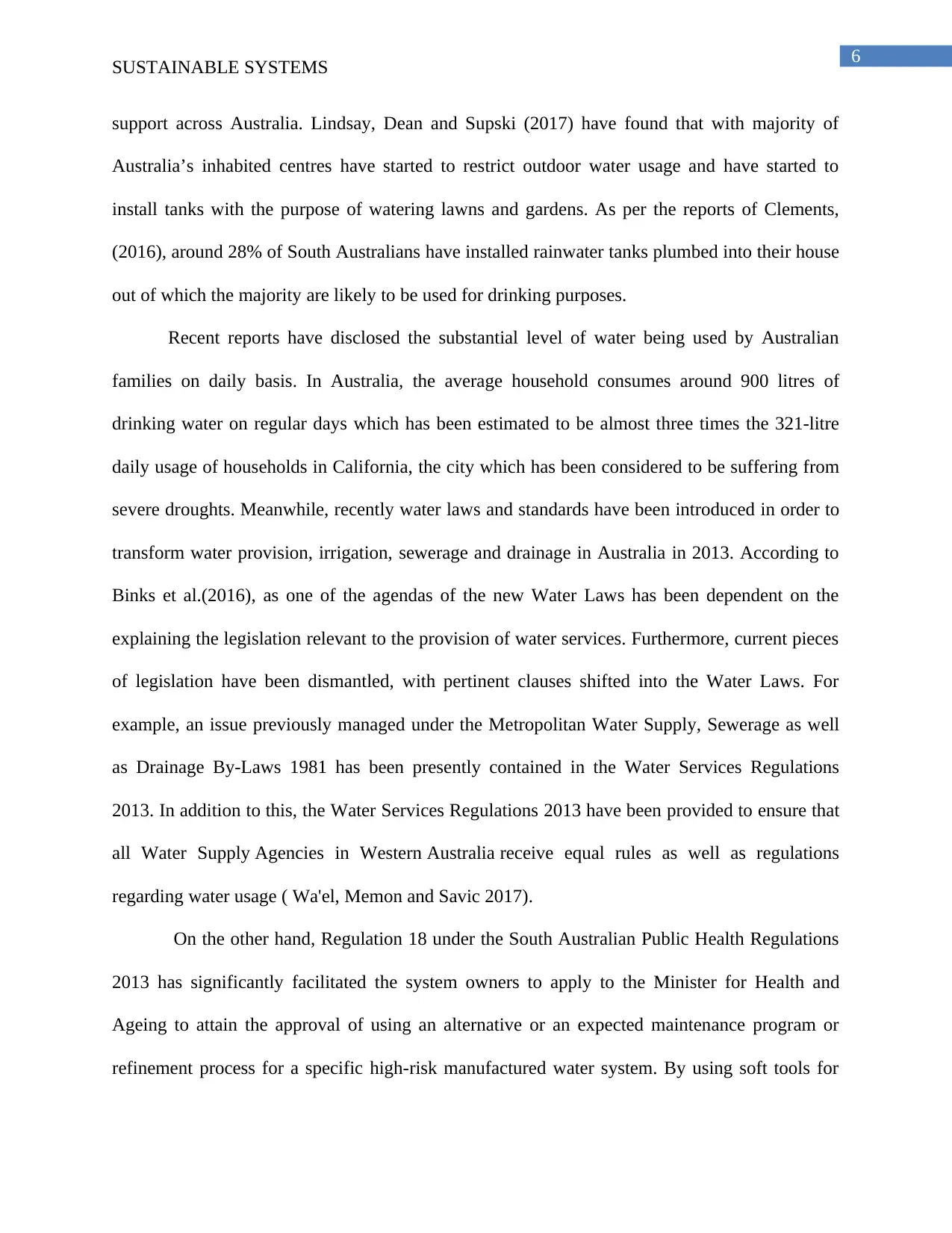
6
SUSTAINABLE SYSTEMS
support across Australia. Lindsay, Dean and Supski (2017) have found that with majority of
Australia’s inhabited centres have started to restrict outdoor water usage and have started to
install tanks with the purpose of watering lawns and gardens. As per the reports of Clements,
(2016), around 28% of South Australians have installed rainwater tanks plumbed into their house
out of which the majority are likely to be used for drinking purposes.
Recent reports have disclosed the substantial level of water being used by Australian
families on daily basis. In Australia, the average household consumes around 900 litres of
drinking water on regular days which has been estimated to be almost three times the 321-litre
daily usage of households in California, the city which has been considered to be suffering from
severe droughts. Meanwhile, recently water laws and standards have been introduced in order to
transform water provision, irrigation, sewerage and drainage in Australia in 2013. According to
Binks et al.(2016), as one of the agendas of the new Water Laws has been dependent on the
explaining the legislation relevant to the provision of water services. Furthermore, current pieces
of legislation have been dismantled, with pertinent clauses shifted into the Water Laws. For
example, an issue previously managed under the Metropolitan Water Supply, Sewerage as well
as Drainage By-Laws 1981 has been presently contained in the Water Services Regulations
2013. In addition to this, the Water Services Regulations 2013 have been provided to ensure that
all Water Supply Agencies in Western Australia receive equal rules as well as regulations
regarding water usage ( Wa'el, Memon and Savic 2017).
On the other hand, Regulation 18 under the South Australian Public Health Regulations
2013 has significantly facilitated the system owners to apply to the Minister for Health and
Ageing to attain the approval of using an alternative or an expected maintenance program or
refinement process for a specific high-risk manufactured water system. By using soft tools for
SUSTAINABLE SYSTEMS
support across Australia. Lindsay, Dean and Supski (2017) have found that with majority of
Australia’s inhabited centres have started to restrict outdoor water usage and have started to
install tanks with the purpose of watering lawns and gardens. As per the reports of Clements,
(2016), around 28% of South Australians have installed rainwater tanks plumbed into their house
out of which the majority are likely to be used for drinking purposes.
Recent reports have disclosed the substantial level of water being used by Australian
families on daily basis. In Australia, the average household consumes around 900 litres of
drinking water on regular days which has been estimated to be almost three times the 321-litre
daily usage of households in California, the city which has been considered to be suffering from
severe droughts. Meanwhile, recently water laws and standards have been introduced in order to
transform water provision, irrigation, sewerage and drainage in Australia in 2013. According to
Binks et al.(2016), as one of the agendas of the new Water Laws has been dependent on the
explaining the legislation relevant to the provision of water services. Furthermore, current pieces
of legislation have been dismantled, with pertinent clauses shifted into the Water Laws. For
example, an issue previously managed under the Metropolitan Water Supply, Sewerage as well
as Drainage By-Laws 1981 has been presently contained in the Water Services Regulations
2013. In addition to this, the Water Services Regulations 2013 have been provided to ensure that
all Water Supply Agencies in Western Australia receive equal rules as well as regulations
regarding water usage ( Wa'el, Memon and Savic 2017).
On the other hand, Regulation 18 under the South Australian Public Health Regulations
2013 has significantly facilitated the system owners to apply to the Minister for Health and
Ageing to attain the approval of using an alternative or an expected maintenance program or
refinement process for a specific high-risk manufactured water system. By using soft tools for
Paraphrase This Document
Need a fresh take? Get an instant paraphrase of this document with our AI Paraphraser
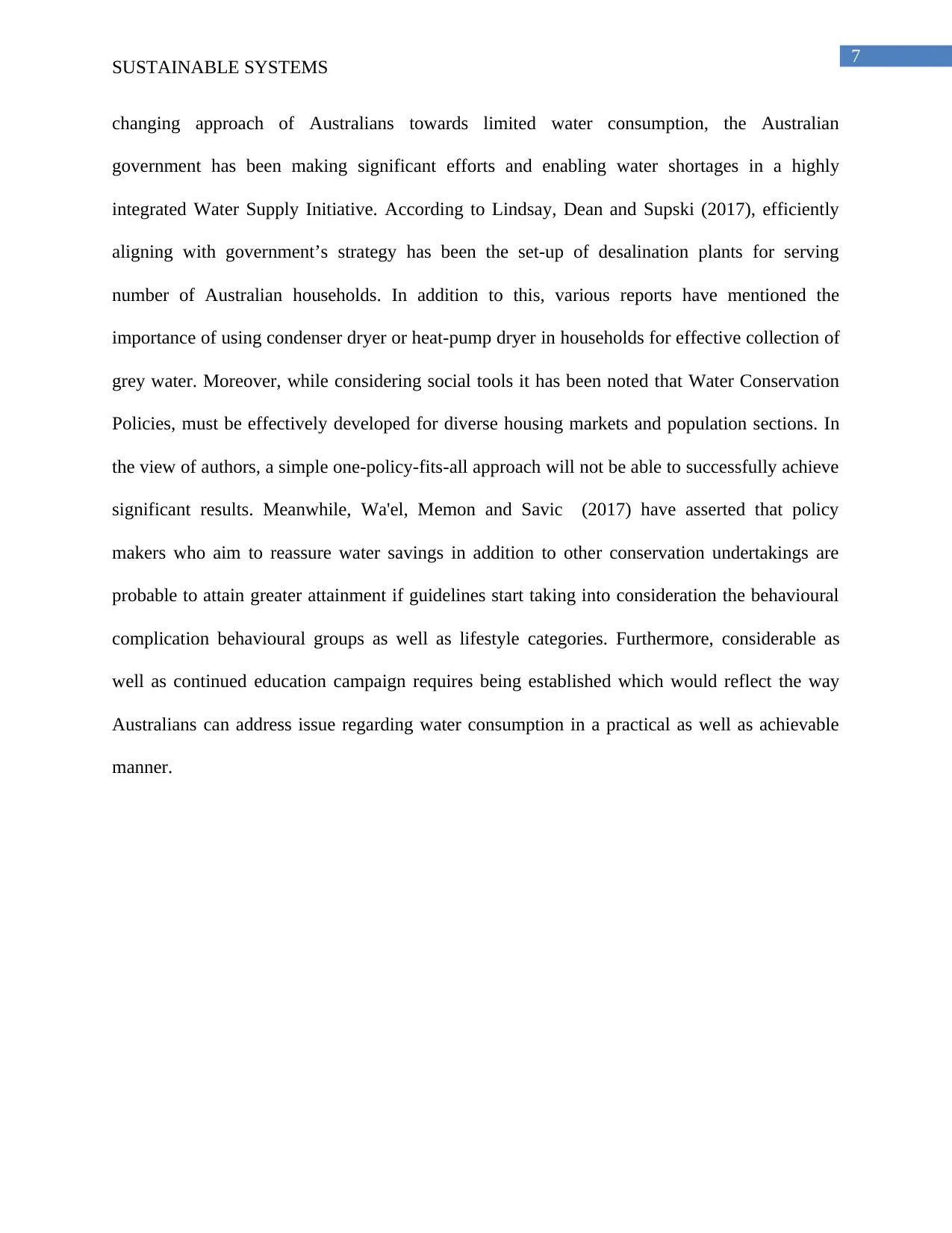
7
SUSTAINABLE SYSTEMS
changing approach of Australians towards limited water consumption, the Australian
government has been making significant efforts and enabling water shortages in a highly
integrated Water Supply Initiative. According to Lindsay, Dean and Supski (2017), efficiently
aligning with government’s strategy has been the set-up of desalination plants for serving
number of Australian households. In addition to this, various reports have mentioned the
importance of using condenser dryer or heat-pump dryer in households for effective collection of
grey water. Moreover, while considering social tools it has been noted that Water Conservation
Policies, must be effectively developed for diverse housing markets and population sections. In
the view of authors, a simple one-policy-fits-all approach will not be able to successfully achieve
significant results. Meanwhile, Wa'el, Memon and Savic (2017) have asserted that policy
makers who aim to reassure water savings in addition to other conservation undertakings are
probable to attain greater attainment if guidelines start taking into consideration the behavioural
complication behavioural groups as well as lifestyle categories. Furthermore, considerable as
well as continued education campaign requires being established which would reflect the way
Australians can address issue regarding water consumption in a practical as well as achievable
manner.
SUSTAINABLE SYSTEMS
changing approach of Australians towards limited water consumption, the Australian
government has been making significant efforts and enabling water shortages in a highly
integrated Water Supply Initiative. According to Lindsay, Dean and Supski (2017), efficiently
aligning with government’s strategy has been the set-up of desalination plants for serving
number of Australian households. In addition to this, various reports have mentioned the
importance of using condenser dryer or heat-pump dryer in households for effective collection of
grey water. Moreover, while considering social tools it has been noted that Water Conservation
Policies, must be effectively developed for diverse housing markets and population sections. In
the view of authors, a simple one-policy-fits-all approach will not be able to successfully achieve
significant results. Meanwhile, Wa'el, Memon and Savic (2017) have asserted that policy
makers who aim to reassure water savings in addition to other conservation undertakings are
probable to attain greater attainment if guidelines start taking into consideration the behavioural
complication behavioural groups as well as lifestyle categories. Furthermore, considerable as
well as continued education campaign requires being established which would reflect the way
Australians can address issue regarding water consumption in a practical as well as achievable
manner.
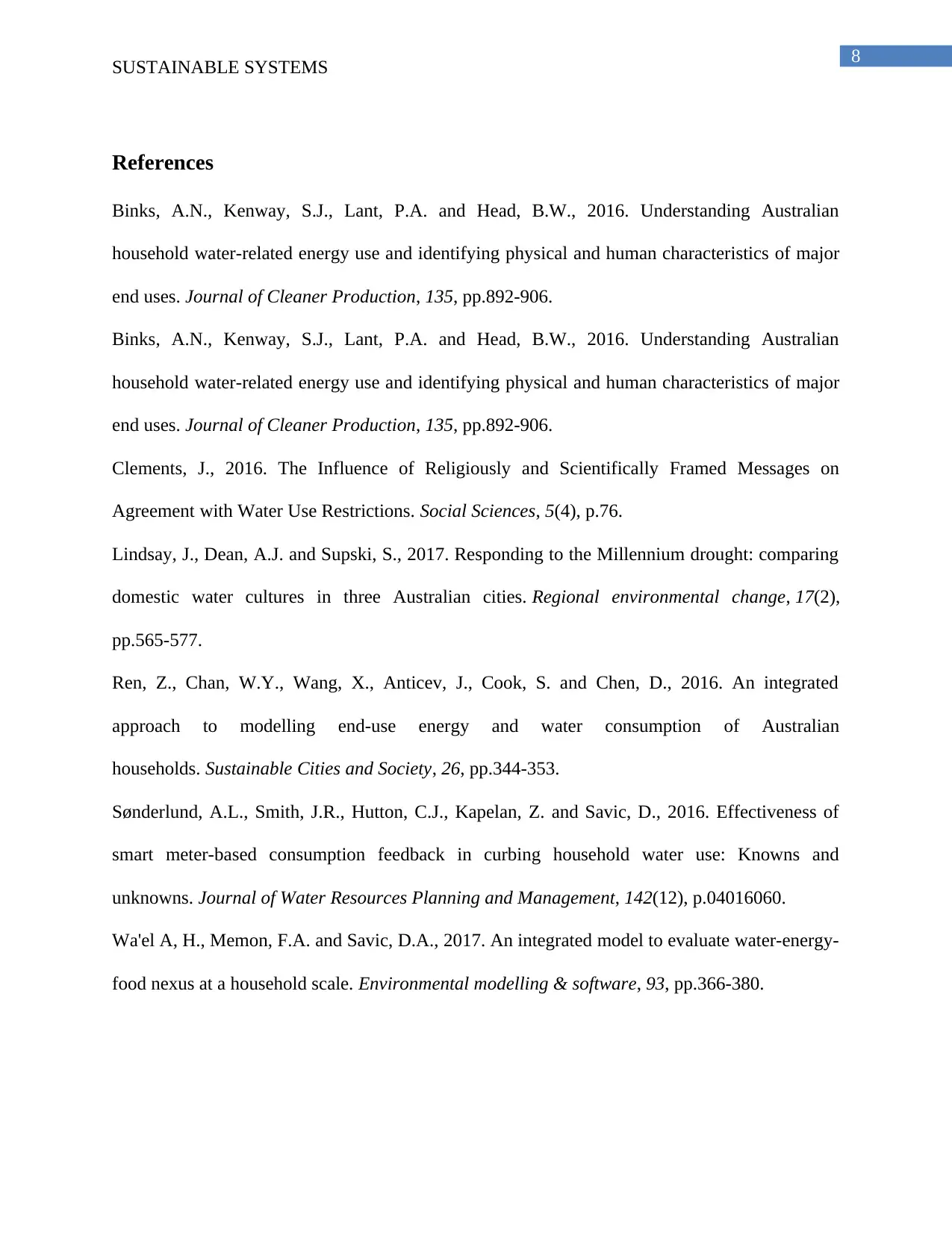
8
SUSTAINABLE SYSTEMS
References
Binks, A.N., Kenway, S.J., Lant, P.A. and Head, B.W., 2016. Understanding Australian
household water-related energy use and identifying physical and human characteristics of major
end uses. Journal of Cleaner Production, 135, pp.892-906.
Binks, A.N., Kenway, S.J., Lant, P.A. and Head, B.W., 2016. Understanding Australian
household water-related energy use and identifying physical and human characteristics of major
end uses. Journal of Cleaner Production, 135, pp.892-906.
Clements, J., 2016. The Influence of Religiously and Scientifically Framed Messages on
Agreement with Water Use Restrictions. Social Sciences, 5(4), p.76.
Lindsay, J., Dean, A.J. and Supski, S., 2017. Responding to the Millennium drought: comparing
domestic water cultures in three Australian cities. Regional environmental change, 17(2),
pp.565-577.
Ren, Z., Chan, W.Y., Wang, X., Anticev, J., Cook, S. and Chen, D., 2016. An integrated
approach to modelling end-use energy and water consumption of Australian
households. Sustainable Cities and Society, 26, pp.344-353.
Sønderlund, A.L., Smith, J.R., Hutton, C.J., Kapelan, Z. and Savic, D., 2016. Effectiveness of
smart meter-based consumption feedback in curbing household water use: Knowns and
unknowns. Journal of Water Resources Planning and Management, 142(12), p.04016060.
Wa'el A, H., Memon, F.A. and Savic, D.A., 2017. An integrated model to evaluate water-energy-
food nexus at a household scale. Environmental modelling & software, 93, pp.366-380.
SUSTAINABLE SYSTEMS
References
Binks, A.N., Kenway, S.J., Lant, P.A. and Head, B.W., 2016. Understanding Australian
household water-related energy use and identifying physical and human characteristics of major
end uses. Journal of Cleaner Production, 135, pp.892-906.
Binks, A.N., Kenway, S.J., Lant, P.A. and Head, B.W., 2016. Understanding Australian
household water-related energy use and identifying physical and human characteristics of major
end uses. Journal of Cleaner Production, 135, pp.892-906.
Clements, J., 2016. The Influence of Religiously and Scientifically Framed Messages on
Agreement with Water Use Restrictions. Social Sciences, 5(4), p.76.
Lindsay, J., Dean, A.J. and Supski, S., 2017. Responding to the Millennium drought: comparing
domestic water cultures in three Australian cities. Regional environmental change, 17(2),
pp.565-577.
Ren, Z., Chan, W.Y., Wang, X., Anticev, J., Cook, S. and Chen, D., 2016. An integrated
approach to modelling end-use energy and water consumption of Australian
households. Sustainable Cities and Society, 26, pp.344-353.
Sønderlund, A.L., Smith, J.R., Hutton, C.J., Kapelan, Z. and Savic, D., 2016. Effectiveness of
smart meter-based consumption feedback in curbing household water use: Knowns and
unknowns. Journal of Water Resources Planning and Management, 142(12), p.04016060.
Wa'el A, H., Memon, F.A. and Savic, D.A., 2017. An integrated model to evaluate water-energy-
food nexus at a household scale. Environmental modelling & software, 93, pp.366-380.
⊘ This is a preview!⊘
Do you want full access?
Subscribe today to unlock all pages.

Trusted by 1+ million students worldwide
1 out of 9
Related Documents
Your All-in-One AI-Powered Toolkit for Academic Success.
+13062052269
info@desklib.com
Available 24*7 on WhatsApp / Email
![[object Object]](/_next/static/media/star-bottom.7253800d.svg)
Unlock your academic potential
Copyright © 2020–2025 A2Z Services. All Rights Reserved. Developed and managed by ZUCOL.




